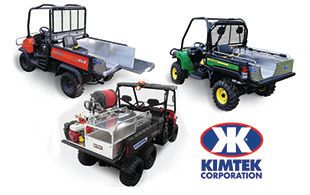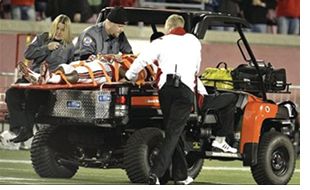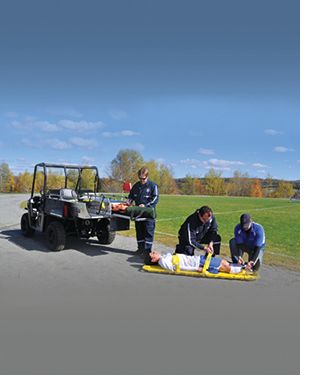Essential precautions for deploying side-by-sides with rescue skid units
By Kimball Johnson, President, KIMTEK Corporation Ret. Fire Chief, Westmore, VT Fire & Rescue
UTV chassis side-by-sides outfitted with appropriate medical or fire skid units complement most any agency’s first response fleet. Safety concerns surrounding their use, particularly when used for patient transport, warrant careful attention from rescue teams. A thorough understanding of the vehicle, transport apparatus, off-road terrain, and patient requirements must precede any use in public safety situations.
 First understand the vehicle
First understand the vehicle
Before considering the advantages of using a patient transport skid unit for side-by-side UTVs, understand the design and limitations of the off-road vehicle in which it fits. (Please reference Kimball Johnson’s earlier article titled, “Not All UTVs Are Created Equal.”) Most of the larger UTV chassis available today, such as John Deere Gator, Polaris Ranger, Gravely Atlas, and Kubota RTV, to name a few, can dependably accommodate the transport of a patient. Slip-on skid units for medical or fire rescue, such as KIMTEK’s MEDLITE® and FIRELITE® units, are specifically equipped for safe transport of patients in compatible UTVs and in some pick-up trucks.
Next understand the missions
Fire and EMS teams must clearly understand the likely mission objectives and what is expected of the equipment in the field. Types of terrain, for example, will help inform which UTV chassis is best for the mission. Sand or rock, flat areas or mountains, and other features of location are all important factors in the decision.
Choosing the right equipment also depends on what type of calls the department anticipates. Will the vehicle cover bicycle trails too narrow for larger ambulances? Will it cover wooded areas where hunting, fishing, and horseback riding are popular? Will the vehicle need equipment for the dual service of fighting wildfires as well as providing medical transport? Perhaps the coverage area includes beaches or vast stadium areas with large concentrations of people. The types of medical treatment likely for each coverage area also affect equipment decisions. Are heart attacks, heat stroke, and shortness of breath more likely than traumatic type injuries from bicycle riding, horseback riding, and motorcycle and ATV accidents? Consideration of all these factors is essential when selecting the right UTV side-by-side chassis and the medical and fire rescue slip-on transport unit that best meets the needs of the call area.
 Patient comfort and safety
Patient comfort and safety
How best to transport patients is the next decision. When immobilization of a patient’s neck and spine is required because of suspected traumatic injury, a skid unit equipped with a long board or stokes basket should be sufficient. If a medical emergency occurs along paved or hard surfaces, such as a local road race or inside a stadium, consider a skid unit that carries a full-wheeled cot stretcher, such as a Stryker® or Ferno®, to transport patients in a position of comfort.
In accordance with the rescue service mandate to “do no further harm to the patient,” a complete understanding of the UTV, the skid unit, and how they work together is necessary to meet that goal. These units are not meant to transport patients at high rates of speed over rough and uneven terrain; rather they are designed and built to safely and professionally transport patients in a manner that would be relatively faster than transport on foot.
Occasions may arise when removing a patient from the UTV skid unit mid-transport is required in order to safely traverse a particularly difficult or dangerous part of the trail, such as in a steep incline or deep water crossing.* The rescue team leader may decide to lift off and hand carry the stokes basket or long board with the patient over an obstacle, then securely remount the patient once safely beyond it for transfer to a waiting ambulance or command post.
 Training is essential
Training is essential
Once a team has identified the purpose and model for its new UTV side-by-side rescue vehicle and properly outfitted it with the appropriate skid unit, lights, and perhaps a radio, enacting several different training drills and scenarios is key. Every department and agency should develop and incorporate a full set of standard operating guidelines or procedures (SOG or SOP) that encompass operation of the vehicle, loading and securing a patient onto the skid unit, and overall guidance on how teams will handle obstacles and incidents along the trail or through the rescue site.
To assist rescue service teams in their training, KIMTEK provides a complete installation and safety manual with every skid unit sold. The manual covers basic safety concerns and suggests solutions to particular coverage area challenges. KIMTEK reminds its customers that UTV-based rescue vehicles fully deserve the same respect that larger ambulances and fire apparatus receive because serious injury to rescue personnel or patients can result if proper training and operation procedures are not followed. Even though these specially equipped public safety vehicles may not leave the fire or EMS bay every day, their unique purpose and custom design make them worth every penny to rescuers and their patients.
*KIMTEK recommends that patients never be transported through high water where a rollover could occur, risking further patient injury or drowning.
About KIMTEK Corporation
KIMTEK is the largest producer and marketer of skid units specific to emergency service ATVs, UTVs, and compact pick-up trucks for public safety agencies in the U.S. KIMTEK’s slide-in FIRELITE® fire and rescue skid units and MEDLITE® medical skid units are now in service in all fifty states, all branches of the military, the National Park Service, numerous sporting complexes, and in Canada and several countries abroad. KIMTEK is an approved contractor for the General Services Agency (GSA) Advantage program. KIMTEK Transport skid units are made in the USA.
KIMTEK Corporation was founded in 1984 as a research and development company dedicated to advances in life safety technology in the fire sciences. For more information, please contact KIMTEK at 888-546-8358 or visit the company’s website at www.kimtekresearch.com.











